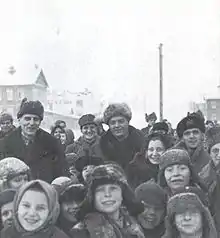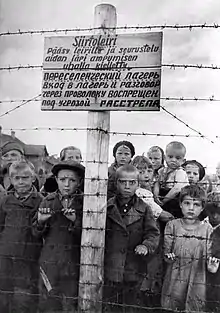East Karelian concentration camps
East Karelian concentration camps were special internment camps in the areas of the Soviet Union occupied by the Finnish military administration during the Continuation War. These camps were organized by the armed forces supreme commander Carl Gustaf Emil Mannerheim.[4] The camps were intended to hold camp detainees for future exchange with the Finnic population from the rest of Russia. The mortality rate of civilians in the camps was high due to famine and disease: by some estimates, 4279 civilians died in these camps, meaning a rough mortality rate of 17%.[5]


Russian population
Significant numbers of Soviet civilians were interred in the concentration camps. These were primarily Russian women, children, and the elderly, as almost all of the working age male and female population were either drafted or evacuated by the Soviets. Only a third of the original population of 470,000 remained in East Karelia when the Finnish army arrived, and half of them were Karelians. About 30 percent (24,000) of the remaining Russian population were confined in camps; six-thousand of them were Soviet refugees captured while they awaited transportation over Lake Onega, and 3,000 were from the southern side of the River Svir. The primary purpose of the detention was to secure the area behind the front lines against partisan attacks. The first of the camps were set up on 24 October 1941 in Petrozavodsk. During the spring and summer of 1942, about 3,500 detainees died of malnutrition. During the second half of 1942, the number of detainees dropped quickly to 15,000 as people were released to their homes or were resettled to the "safe" villages, and only 500 more people died during the last two years of war, as the food shortages were alleviated.[6][7] During the following years, the Finnish authorities detained several thousand more civilians from areas with reported partisan activity, but as the releases continued the total number of detainees remained at 13,000–14,000. According to the records the total number of deaths among the interned civilians and POWs was 4,631[8] (earlier estimates varied between 4,000 and 7,000), mostly from hunger during the spring and summer of 1942.[7][9]
Timeline
The first camp was set up on 24 October 1941, in Petrozavodsk. The two largest groups were 6,000 Russian refugees and 3,000 inhabitants from the southern bank of the River Svir who were forcibly evacuated because of the close proximity of the front line. Of these interned civilians it has been estimated that 4361 perished mainly due to malnourishment, 90 percent of them during the spring and summer of 1942.[7][8]
Population in the Finnish camps:
| Number of inmates | Date |
|---|---|
| 13400 | December 31, 1941 |
| 21984 | July 1, 1942 |
| 15241 | January 1, 1943 |
| 14917 | January 1, 1944 |
List of the camps
- Keskitysleiri 1
- Keskitysleiri 2
- Keskitysleiri 3
- Keskitysleiri 4
- Keskitysleiri 5
- Keskitysleiri 6
- Kutisma camp
- Vilka camp
- Tervaoja camp
See also
References
- See: Laine, Antti 1982: Suur-Suomen kahdet kasvot. Itä-Karjalan siviiliväestön asema suomalaisessa miehityshallinnossa 1941–1944, pp. 116, 346–348, & appendix with illustrations. Helsinki: Otava.
- Geust, Carl-Fredrik (2007). "Murjottavat ja nauravat Äänislinnan lapset" [Sulking and laughing children of Petrozavodsk]. Sotilasaikakauslehti (11): 44–45.
- (in Russian) Семейный Ковчег: "Военное детство нынче не в цене", April 2004
- Laine, Antti 1982: Suur-Suomen kahdet kasvot. Itä-Karjalan siviiliväestön asema suomalaisessa miehityshallinnossa 1941–1944, s. 63, 67, 116, 125. Helsinki: Otava.
- Kinnunen, Tiina; Kivimäki, Ville (2011-11-25). Finland in World War II: History, Memory, Interpretations. BRILL. p. 389. ISBN 978-90-04-20894-0.
- Maanpuolustuskorkeakoulun historian laitos, Jatkosodan historia 1–6 ("The History of The Continuation War, 1–6"), 1994
- Laine, Antti, Suur-Suomen kahdet kasvot, 1982, ISBN 951-1-06947-0, Otava
- Westerlund 2008, p. 8
- (in Russian)""Равнение на Победу" (Eyes toward victory), the Republic of Karelia" (in Russian). the Ministry of Education and Science of the Russian Federation, National Delphi Council of Russia. Archived from the original on 2005-11-02. Retrieved 2006-08-10.
Bibliography
- Westerlund, Lars, ed. (2008). Sotavangit ja internoidut : Kansallisarkiston artikkelikirja [Prisoners of war and internees : a book of articles by the National Archives] (PDF) (in English, Finnish, and Norwegian). Helsinki: Kansallisarkisto. p. 568. ISBN 9789515331397. Archived from the original (PDF) on August 15, 2014. Retrieved October 25, 2016.